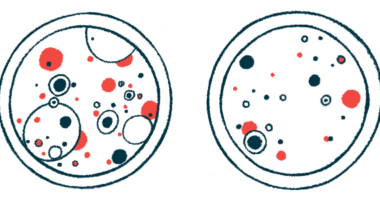Stopping Neutrophil Webs May Benefit Patients With Lung Fibrosis

Antimicrobial webs produced by neutrophils — immune cells that respond quickly to bodily injury — may be implicated in the development of ANCA-associated vasculitis (AAV) accompanied by lung scarring (fibrosis), a recent review of several published studies revealed.
These webs of DNA and antimicrobial proteins are known as neutrophil extracellular traps, or NETs. Blocking them may be a promising treatment approach for AAV, according to researchers.
“The pharmacological or genetic inhibition of NET release reduces disease severity in multiple inflammatory disease models, indicating that NETs are potential therapeutic targets,” the researchers wrote.
The review study, “Neutrophil Extracellular Traps in ANCA-Associated Vasculitis and Interstitial Lung Disease: A Scoping Review,” was published in the journal Life.
Normally, NETs surround neutrophils, capturing and killing nearby microbes. In AAV, however, neutrophils are overactive and overproduce NETs, which release a variety of pro-inflammatory molecules and damage signals that wrongfully contribute to autoimmunity and tissue damage.
Furthermore, NETs observed in AAV are resistant to the processes by which they would normally be broken down.
Conditions leading to lung scarring, or fibrosis, such as interstitial lung disease (ILD) and pulmonary fibrosis (PF), are sometimes seen in association with AAV and are linked to a worse prognosis. It has been suggested that NET dysfunction also may contribute to these conditions.
To better understand the potential role of NETs in lung fibrosis and AAV, researchers in Italy now reviewed 20 previously published studies on the topic.
In general, data suggested that NETs are implicated in AAV and lung fibrosis, and their inhibition may be a promising new therapeutic strategy.
In AAV patients, increased NET production was observed during periods of active disease, and neutrophils from AAV patients released more NETs in culture than did cells from healthy donors.
Studies also indicated that therapeutic strategies that block NET formation in AAV may be beneficial. For example, immunoglobulin therapy stopped NET formation and eased AAV development in cells and animal models.
In another study, a blockade of an inflammatory molecule called CXCL4 in platelets — cell fragments that form clots to prevent bleeding and are involved in NET production — from AAV patients significantly reduced NET formation. CXCL4 may thus represent a therapeutic target for preventing NETs in AAV, the researchers noted.
NETs also have been implicated in the development of lung fibrosis. Overall, studies showed the lungs are particularly susceptible to NET-induced damage, including that observed in asthma, ILD, and lung fibrosis following COVID-19 infection.
In patients with ILD, NETs were observed near fibroblasts — connective tissue cells that release collagen and other proteins to help maintain tissue integrity. In fibrotic diseases, fibroblasts are dysregulated, leading to collagen overproduction and to the buildup of scar tissue.
Other studies in cell cultures indicated that NETs actively promote fibrosis, which could be countered by destroying NETs with DNase, an enzyme that degrades DNA.
Furthermore, inhibition of neutrophil elastase or peptidyl arginine deiminase (PAD), both of which are involved in NET formation, was beneficial in PF mouse models.
“Altogether, these findings point to a key role of NETs in the development and progression of PF,” the team wrote.
While NETs are implicated individually in AAV and lung fibrosis, how NETs might associate the two diseases remains unclear.
It has been hypothesized that in AAV, activated neutrophils produce NETs that then release proteins that alter the composition of the extracellular matrix — the network of molecules that surrounds and supports cells in tissues. Specifically, collagen production may be increased, thereby promoting fibrosis in AAV.
Some evidence suggests that traditional immunosuppressants used for AAV, such as rituximab (sold as Rituxan, among other brand names), which reduces the number of antibody-producing immune B- cells, may not be beneficial in AAV patients with ILD, and this subset of patients are usually excluded from clinical trials.
According to researchers, the literature suggests that NET blockade may be a promising therapeutic approach for these patients, although this has not yet been tested in in-human trials as yet.
“Despite the lack of clinical data, we may hypothesize that an optimal management of AAV-ILD patients would require not only B-cells’ targeted therapy but also NET inhibition,” they wrote.
The team noted that this hypothesis will be better supported by a further understanding of the molecular mechanisms underlying NET involvement in AAV and lung fibrosis.
“Although it can be speculated that NETs in patients with AAV-ILD could reduce severity and mortality, a scientific basis that could improve our understanding of the disease from a molecular point of view is lacking,” they concluded.







